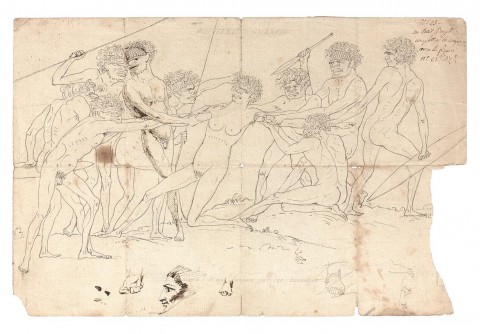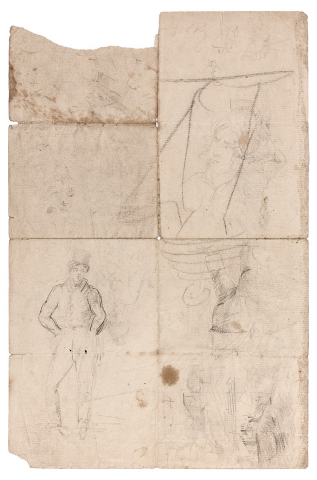RECTO: NOUVELLE HOLLANDE … MASSACRE D’UNE FEMME PAR LES SAUVAGES (ABORIGINAL WOMAN BEING COMPETED FOR BY TWO RIVAL GROUPS OF ABORIGINAL MEN, WITH FIVE FIGURES ON THE LEFT AND FOUR ON THE RIGHT), prior to 1804
NICOLAS-MARTIN PETIT
pen and ink on laid paper watermarked “Bugden 1801”
217 x 332 mm (sheet, irregular)
bears inscription upper right: five-line ink note in Péron’s hand No. 23 au trait…
Ultimately published as plate 104 in the Freycinet atlas of 1825, noted as Sébastien Leroy (dess.) after Petit
No such scene recorded at Le Havre, but see the sheet of thumbnail “scenes from Aboriginal life” which alludes to an unpictured scene, “massacre d’une femme” (B:16009)
The second preliminary sketch relating to the “Port-Jackson, Nlle. Hollande: cérémonie préliminaire d’un mariage, chez les sauvages”, plate 104 in the Freycinet atlas of 1825.
If anything this is a yet more violent scene than the first version, here featuring ten figures in total: five men competing with four on the right, one of the latter holding his woomera above his head. The woman they are fighting over is here facing the viewer directly, her legs askew, her hair being pulled and with no fewer than seven of the men pulling on her arms. This makes the scene still more unsettling, but also means that it is possible to see the scarification Petit has figured on her torso, which may help unravel aspects of the scene.
Again there is much here which helps us understand how Petit worked, notably the way he has very clearly highlighted one man (fourth from the left) as a way of trialling a slightly different overall composition. As with many of the Le Havre works this has notes relating to the planned plate at upper left (in Péron’s distinctive hand) which can be compared with similar notes on drawings lots 2, 3 and 12. Its significance regarding the dating of this drawing is discussed in the note to lot 12.
Another intriguing inclusion here is the pencilled-in title “Nouvelle Hollande” at the top. Many of the Le Havre studies have a similar pencil title, which may have been meant as a way of visually tying all of the material together, but was not used in the finished plates.
At the bottom of the sheet the series of rough sketches (discussed at lot 13b) has an original pencil caption, the quite blunt “[ma]ssacre d’une femme par les sauvages”, which is of course quite different from that used on the finished plate in 1825. When was the pencil caption to the present view added? Could it be that the later use of “mar iage” in the printed caption is a misprision?

